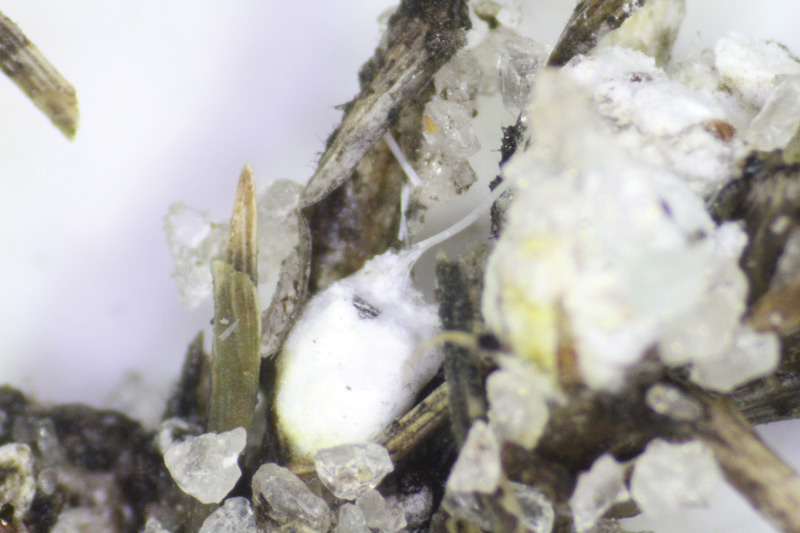
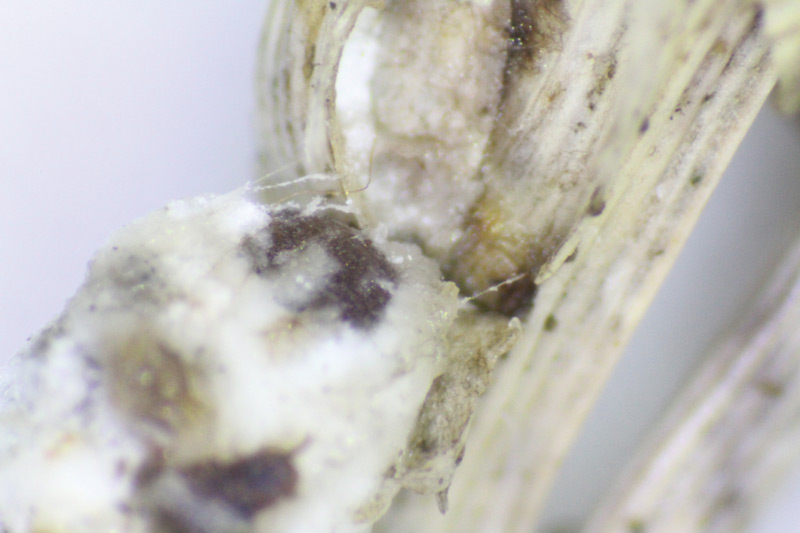
Figure 1. Top: Adult rhodesgrass mealybug covered with white wax layer. Bottom: The wax layer is removed to reveal the purplish body. The long, waxy filament protruding from the rear end of the mealybugs is an identifying characteristic. Photos by Shimat Joseph
Rhodesgrass mealybug, Antonina graminis (Maskell), is an invasive insect from Asia. First found in the United States in Texas in 1942, rhodesgrass mealybug has since been found in the Carolinas, through the southern United States and to Southern California (2, 6). Originally described based on specimens collected from Rhodes grass (Chloris gayana) in Hong Kong, rhodesgrass mealybug can infest more than 100 grass species, including all warm-season grasses commonly used for hay and turf, some cool-season grasses (such as tall fescue), grassy crops (such as sugar cane and sorghum) and weedy grass species (such as hairy crabgrass).
We have observed significant infestations and damage of bermudagrass turf by rhodesgrass mealybug in recent years. Light infestations are frequently found in residential and commercial lawns, parks, athletic fields, hayfields, pastures, rights-of-way and naturalized areas. Light infestations typically do not cause noticeable damage and thus do not require management.
Of particular concern to us, however, are the increasingly frequent reports of rhodesgrass mealybug infestation and damage on golf greens. Although rhodesgrass mealybug infestation can be found on all parts of a golf course, infestation on greens is the most damaging and noticeable. We will summarize in this article existing biological and management information about rhodesgrass mealybug and our recent research on its management on golf greens.
Rhodesgrass mealybug: Description and life cycle
All rhodesgrass mealybug life stages are found attached to grass nodes. Younger and smaller mealybugs are light-colored and concealed by leaf sheaths, making them difficult to see. Similar to other mealybug species, adult rhodesgrass mealybugs are covered by a thick layer of woolly white wax, making them look like grains of rice protruding from under the leaf sheaths (Figure 1, above). Adults are dark red or purple when the wax layer is removed. The most characteristic structure useful for identification is a long, hollow wax tube that protrudes from the rear end of an adult.
Rhodesgrass mealybug biology was examined in detail in a 1960 study (3). A population is composed almost entirely of females. Males, which resemble small, fragile gnats, are rare. Because of the rarity of males, the majority of rhodesgrass mealybugs reproduce without mating. Each female produces up to 200 eggs.
Hatchlings (also called “crawlers”) move away from their parents to feed on other grass nodes. These crawlers disperse by walking, or by being carried by the wind or on clippings or equipment. The crawlers begin to feed on grass nodes as soon as they find a suitable host.
Nymphs lose all legs and antennae during the first molt and enlarge into sacs under the leaf sheaths. Nymphs develop through three instars before becoming adults in about two months. As many as 50 nymphs can feed and develop on the same grass node, but, as the nymphs die from various causes, usually only one to six adults remain on a single grass node at the end of a generation (Chong, unpublished data).
Adults live for about four months and die once egg laying has been completed. Overwintering stage is not known, suggesting they can remain active in the winter months. Reproduction can occur throughout the year, but most females begin reproduction when air temperature exceeds 59 F (15 C). We have observed that the mealybug population builds through the spring and summer, and damage typically becomes more noticeable in late July to September in Georgia and South Carolina.
Rhodesgrass mealybug damage and diagnosis
The rhodesgrass mealybug uses its piercing-sucking mouthparts to suck sap from the phloem. The removal of large amounts of sap and the nutrients contained within the sap can affect turfgrass physiology and health tremendously. In a way, rhodesgrass mealybug acts as a biological stressor on turfgrass; thus, the symptoms of infestation may appear similar to those of other biotic and abiotic stresses.
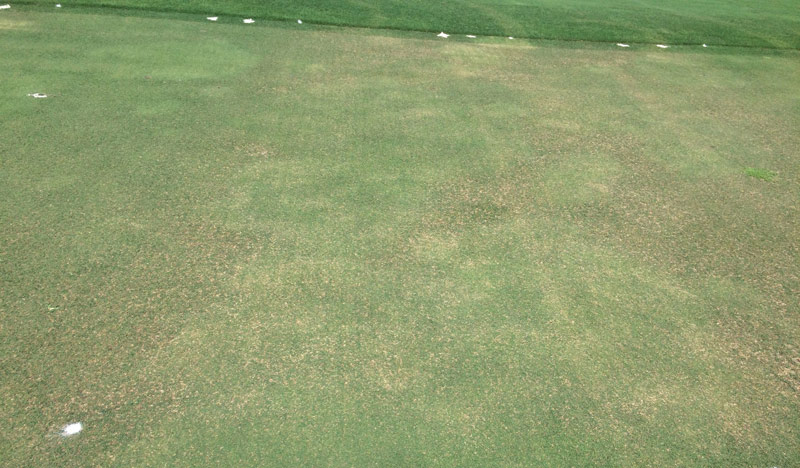
Figure 2. A bermudagrass green infested with rhodesgrass mealybug shows yellowing, a symptom that resembles drought stress. Photo by Juang Chong
Initially, infested turf appears yellow and stunted, similar to symptoms of drought stress (Figure 2, above), and eventually, the entire shoot turns from yellow to brown and dies. Numerous dead blades are intermingled with live blades, and the thinned turf is often invaded by weeds. The damage differs from that caused by drought stress in that increased irrigation or fertilization does not revive growth and quality of infested greens. Older greens also appear more prone to infestation, possibly because the mealybug populations have had time to build up to a damaging level.
After extracting nutrients (particularly amino acids and proteins) from the sap, the mealybugs expel the waste through their wax tubes. A droplet of waste solution can sometimes be seen oozing from the end of the long wax tube. The waste solution is sap devoid of nutrients but full of sugars and other carbohydrates, and it’s commonly known as “honeydew.” Black, sooty mold grows on honeydew droplets that have landed on leaf blades and sand, creating black spots in the thatch. These black spots can be easily found when shoots are parted with fingers, and careful examination of the shoots can reveal the fuzzy adults (which resemble rice grains) attached to the nodes (Figure 3, below). Adults are about 1/8 inch (3 centimeters) long and can usually be seen with the naked eye or with a magnifier or hand lens.
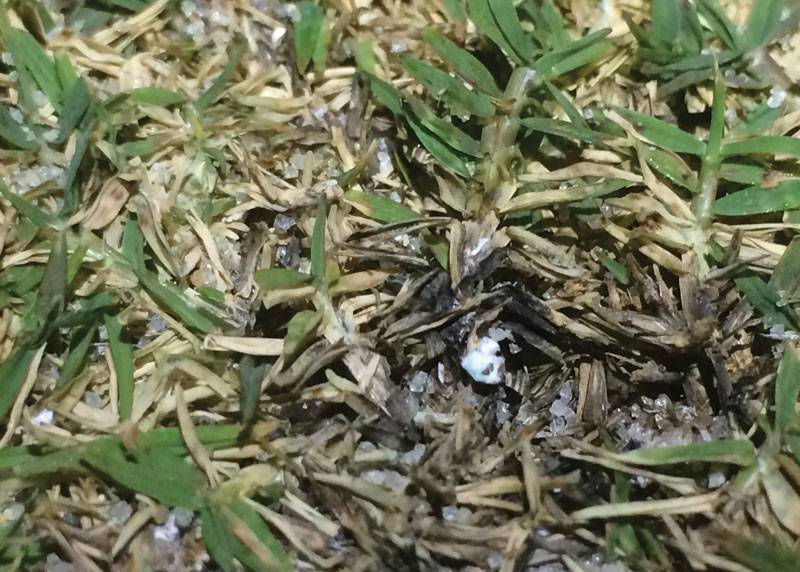
Figure 3. Sooty mold growing on honeydew secreted by rhodesgrass mealybugs often stains the thatch and substrate. Photo by Shimat Joseph
Editor’s note: A turf entomologist details the different insect-monitoring techniques and which work for tracking which insects in Turf insects: Looking for bugs in all the right places.
It has been suggested that the black, sooty mold reduces photosynthesis by blocking sunlight from reaching the leaf surface. It is unclear how much stress or reduction in turf health can be attributed to the reduction of photosynthesis by sooty mold.
We also found the honeydew to be highly attractive to bees, wasps and ants (Figure 4, below). The attraction of stinging insects may increase medical risks, annoyance or fear experienced by golfers.
Turfgrass resistance and cultural control of rhodesgrass mealybug
Among warm-season turfgrass species, bermudagrass appears to be the most susceptible to rhodesgrass mealybugs (7). We have observed infestations on common bermudagrass cultivars grown in hayfields, rights-of-way and naturalized areas, as well as on popular hybrid and ultradwarf cultivars, such as Tifway, TifSport, Tifdwarf, TifEagle, MiniVerde and Champion. St. Augustinegrass, buffalograss and zoysiagrass are intermediately resistant. Centipedegrass, seashore paspalum, bahiagrass and tall fescue are the most resistant (7).
It is not clear why, but in the past 10 years, we have observed an increase in infestation and damage on golf greens, almost all of which are ultradwarf bermudagrass. It is possible that management practices, such as ultra-low mowing height, are stressing the turf and making it more susceptible to damage. A reduction in the use of broad-spectrum insecticides (such as organophosphates and pyrethroids) on greens may lessen the suppression of the mealybug populations. Interference by insecticides and ants may also lessen mealybug population suppression by biological control (see discussion in the next section).
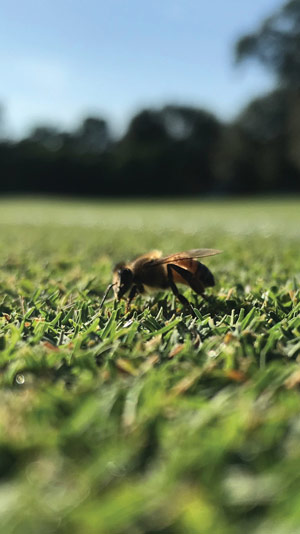
Right: Figure 4. Honey bees are attracted to honeydew produced by rhodesgrass mealybugs. Photo by Robert Wolverton
Because rhodesgrass mealybug is a biological stressor, cultural management practices that can maintain or promote a healthy turf should be practiced in order to reduce stress and damage by the pest. We do not have a good understanding of how rhodesgrass mealybug responds to changes in irrigation and fertilization. It is possible that increased irrigation (to a point that is not conducive to disease development) can help promote turf growth and also allow the turf to withstand mealybug infestation. Increased fertilization on golf greens may produce grass of higher nutritional value, which can potentially increase the mealybugs’ survival and reproduction. Additional studies on rhodesgrass mealybug development under intensive greens management will be needed.
We need to recognize the role clippings may play in dispersing the mealybugs. Nymph and adult rhodesgrass mealybugs can stay alive without feeding for five and six weeks, respectively (1). It is reasonable to assume that adults can remain alive on the clippings (even if the clippings are no longer suitable for feeding) and produce crawlers. Crawlers that are feeding on the clippings can also detach themselves as the clippings are drying. The crawlers can then disperse from the clippings to nearby turf, starting new infestations. Therefore, we advocate for the collection and disposal of clippings from infested greens as well as the cleaning of equipment to remove clippings after mowing infested greens in order to avoid spreading the mealybugs.
Rhodesgrass mealybug biological control
Five parasitic wasp species — Anagyrus antoninae from Hawaii; Pseudectroma europaea, Xanthoencyrtus phragmitis and Boucekiella antoninae from France; and Neodusmetia sangwani from India — were released at several sites in Texas and Florida in the 1950s (4). Only N. sangwani has successfully established (4), and it has contributed to a 50% to 83% reduction in mealybug populations in Texas (5). Mealybug populations remain at low levels and rarely require additional management decades after the introduction of the parasitic wasps, suggesting that this biological control program has been extremely successful. Additional mealybug population suppression may be provided by generalist predators, such as big-eyed bugs and lady beetles (1).
The resurgence of rhodesgrass mealybug as a pest in the past decade may have coincided with a reduction in the effectiveness of biological control. A recent survey found that parasitism in rhodesgrass mealybug populations was sparse and not uniform across the southern U.S. (4). Although the exact reason behind the low levels of parasitism is unknown, invasion by the red imported fire ant (Solenopsis invicta) has been implicated (4). It is believed that fire ants tend the mealybugs for honeydew, and, in return, protect the mealybugs by preventing attacks from the parasitic wasps.
There is no commercial source for purchasing parasitic wasps for release. Releasing parasitic wasps, therefore, is not a feasible approach to reducing the rhodesgrass mealybug population on golf greens. A more sensible approach is to boost the presence, abundance and effectiveness of the existing parasitic wasps and generalist predators by not using broad-spectrum insecticides (such as organophosphates and pyrethroids, which are highly toxic to the natural enemies) or by reducing fire ant populations with baits (baits will likely not impact the natural enemy populations).
Exploring rhodesgrass mealybug insecticide options
Insecticide has not traditionally been the main management tool for rhodesgrass mealybug, because the parasitic wasps were providing sufficient suppression of the populations. While certain pyrethroids are labeled for general mealybug management on turfgrass, no insecticide is labeled specifically against rhodesgrass mealybug.
In our preliminary studies, bifenthrin and alpha-cypermethrin (both pyrethroids) were not effective in reducing rhodesgrass mealybug densities. This preliminary result casts doubt on the efficacy of pyrethroids, although the insecticides are widely used for rhodesgrass mealybug management. The lack of published data on the efficacy of other insecticides against rhodesgrass mealybug has hindered our ability to make management recommendations.
Editor’s note: Ground pearls are a persistent pest in turfgrass growing in sandy soils from North Carolina to Southern California. In Ground pearls in turf, author Juang Horng “JC” Chong, Ph.D., offers a look at the ground pearl’s life stages, the search for chemical controls, and the best current means of addressing it.
We conducted a series of experiments in 2018 and 2019 to explore the potential of managing rhodesgrass mealybug populations with insecticides. The selected active ingredients are registered for use on turfgrass and have shown good to excellent efficacy in suppressing mealybug species on ornamental plants.
Georgia trial, 2018
In a trial conducted on infested TifEagle greens in Georgia in 2018, we evaluated the efficacy of Ference (cyantraniliprole, Syngenta) at 12 fluid ounces/acre (0.88 liter/hectare); Meridian (thiamethoxam, Syngenta) at 8.5 ounces/acre (595.45 grams/hectare); a combination of Ference and Meridian at the previously stated rates; and Zylam Liquid (dinotefuran, PBI-Gordon) at 16 fluid ounces/acre (1.17 liters/hectare).
The insecticides were applied to 25-square-foot (2.3-square-meter) plots three times monthly starting in mid-August, at an application volume of 2 gallons/1,000 square feet (814.92 liters/hectare). A surfactant, Dyne-Amic (Helena Chemical Co.), was added to the solution to increase solution penetration under leaf sheaths. Each treatment was replicated four times. Four 1.6-inch-diameter (4-centimeter-diameter) cores were taken from each plot at one, two, and two and a half months after the first application. The grass cores were brought back to the laboratory at the University of Georgia’s Griffin campus, and the numbers of mealybugs on all grass nodes were counted under microscopes.
In the 2018 trial, we found that all insecticides reduced the numbers of mealybugs within the first month of application when compared with the untreated check (Table 1). Meridian and Ference + Meridian were the most effective, reducing the mealybug numbers by 70% within the first month. Because mean mealybug abundance was essentially the same for Meridian and Ference + Meridian, we believed the reduction was achieved mainly by Meridian. By two and a half months after the first application, plots treated with Meridian and Ference + Meridian continued to harbor fewer mealybugs than the untreated check. The trial results suggest that Meridian was the most effective in reducing mealybug density quickly.
Georgia trial, 2019
In 2019, we conducted a second trial on a TifEagle green in Georgia to evaluate the efficacy of Zylam Liquid and Merit 2F (imidacloprid, Bayer). We speculated that the low rate of Zylam tested in the 2018 trial was the reason this insecticide was not effective against rhodesgrass mealybug, even though its active ingredient, dinotefuran, is one of the most effective insecticides against various mealybug species on ornamental plants.
In the 2019 trial, we increased the application rate of Zylam to the maximum label rate (79 fluid ounces/acre; 5.77 liters/hectare) and applied Merit at 16 fluid ounces/acre (1.17 liters/hectare). No surfactant was used in this trial. The insecticides were applied once in early September at an application volume of 100 gallons/acre (935.40 liters/hectare). Each treatment was replicated six times on a 9-square-foot (0.84-square-meter) plot. Three 0.8-inch-diameter (2-centimeter-diameter) grass cores were collected from each plot weekly for four weeks. The number of mealybugs collected was determined under the microscopes at the University of Georgia’s Griffin campus.
The 2019 trial results (Table 2) suggest that Merit began to reduce mealybug numbers at seven days after treatment, whereas reduction in Zylam-treated plots occurred at 14 days after application. Both products resulted in 45% to 50% fewer mealybugs than the water check at 21 and 28 days after treatment. By 50 days after treatment, live mealybugs numbers were the same among the treatments, which led us to question the true value of using these products for rhodesgrass mealybug management. Zylam appeared to have performed better in this trial than in the 2018 trial. It is important to reiterate that Zylam was applied at the highest label rate in this trial, suggesting that application rate is crucial to the performance of Zylam. The performance of imidacloprid and dinotefuran should be confirmed in future studies.
South Carolina trial, 2019
Another trial was conducted on a Tifdwarf green in South Carolina in 2019. In this trial, Orthene 75 WSP (acephate, AMVAC) at 5.3 pounds/acre (5.9 kilograms/hectare) and a combination of Meridian at 17 ounces/acre (1.19 kilograms/hectare) and Dyne-Amic at 0.4% were applied twice at a 14-day interval to 150-square-foot (13.9-square-meter) plots at an application volume of 2 gallons/1,000 square feet in August. Three 2-inch-diameter (5-centimeter-diameter) cores were collected from each plot at one and two months after the first application, and the number of rhodesgrass mealybugs was counted in the laboratory at the Clemson University Pee Dee Research and Education Center.
In the South Carolina trial, the mealybug densities in plots treated with Orthene and Meridian were reduced by 48% within the first month of application and remained at 24% lower than the water check in the second month (Table 3). Results suggest that Orthene and Meridian applied twice are effective in reducing rhodesgrass mealybug densities.
Conclusions
Our experiments suggest that Orthene and Meridian showed the greatest and most consistent potential in reducing rhodesgrass mealybug abundance. These insecticides should be applied at high label rates and at twice-monthly or monthly intervals in August to target adult females and their crawlers.
Despite their potential, acephate and thiamethoxam are not silver bullets against rhodesgrass mealybug, because the mealybug populations were not eliminated satisfactorily (that is, greater than 85% reduction) within our trial periods. We believe treatment with acephate or thiamethoxam over multiple years may be needed to successfully suppress the mealybug populations.
Merit and Zylam did not perform consistently and warrant further study. To avoid overreliance on only two classes of insecticides (acephate is an organophosphate; dinotefuran, imidacloprid and thiamethoxam are neonicotinoids), additional studies will be conducted in the next few years to identify other insecticides that are effective against rhodesgrass mealybug.
Acephate and neonicotinoids (dinotefuran, imidacloprid and thiamethoxam) are broad-spectrum insecticides. It is important to recognize the risks these broad-spectrum insecticides may pose to parasitic wasps and other natural enemies of rhodesgrass mealybug, as well as to bees that forage on the honeydew produced by the mealybug. These insecticides should be applied when honey bees and parasitic wasps are less active on turf, such as late in the evening.
Funding
Experiments outlined in this article were supported by research gifts and materials from BASF, Bayer and Syngenta. We also thank the superintendents of the participating golf courses for providing access to and maintenance of the test plots.
The research says ...
- Rhodesgrass mealybug is an emerging pest of golf greens.
- No insecticide is currently registered specifically for rhodesgrass mealybug management.
- In a series of experiments conducted on greens in Georgia and South Carolina, we identified Orthene and Meridian as the most effective insecticides in reducing rhodesgrass mealybug populations.
- Twice-monthly or monthly applications, starting in August, will be needed over multiple years to completely suppress rhodesgrass mealybug populations.
Literature cited
- Baxendale, F.P., and D.J. Shetlar. 2012. Mealybugs and scale insects. Pages 59-61. In: R.L. Brandenburg and C.P. Freeman, editors. Handbook of turfgrass insects. Second edition. The Entomological Society of America, Lanham, Md.
- Brandenburg, R. 2017. Rhodesgrass mealybug in turf. TurfFiles. North Carolina State University Extension. (https://content.ces.ncsu.edu/rhodesgrass-mealybug-in-turf).
- Chada, H.L., and E.A. Wood Jr. 1960. Biology and control of the Rhodes grass scale. United States Department of Agriculture Technical Bulletin 1221:1-21 (https://pubs.nal.usda.gov/sites/pubs.nal.usda.gov/files/tb.htm#TB1221).
- Chantos, J.M., S. Bradleigh Vinson and K.R. Helms. 2009. Distribution and abundance of parasites of the rhodesgrass mealybug, Antonina graminis: Reassessment of a classic example of biological control in the southeastern United States. Journal of Insect Science 9:48 (https://www.ncbi.nlm.nih.gov/pmc/articles/PMC3011875/).
- Dean, H.A., M.F. Schuster, J.C. Boling and P.T. Riherd. 1979. Complete biological control of Antonina graminis in Texas with Neodusmetia sangwani (A Classic Example). Bulletin of the Entomological Society of America 25(4):262-267 (https://doi.org/10.1093/besa/25.4.262).
- García Morales, M., B.D. Denno, D.R. Miller, G.L. Miller, Y. Ben-Dov and N.B. Hardy. 2016. ScaleNet: A literature-based model of scale insect biology and systematics. Database. (http://scalenet.info).
- Reinert, J.A., and S. Bradleigh Vinson. 2010. Preference among turfgrass genera and cultivars for colonization by rhodesgrass mealybug, Antonina graminis (Hemiptera: Pseudococcidae). Southwestern Entomologist 35(2):121-128 (https://doi:10.3958/059.035.0201).
Shimat Joseph is an assistant professor of turf and ornamentals entomology, and Robert Wolverton is a graduate research assistant in entomology in the Department of Entomology at the University of Georgia, Griffin, Ga. Juang Horng “JC” Chong is a professor of turf and ornamentals entomology in the Department of Plant and Environmental Sciences at Clemson University, Pee Dee Research and Education Center, Florence, S.C.